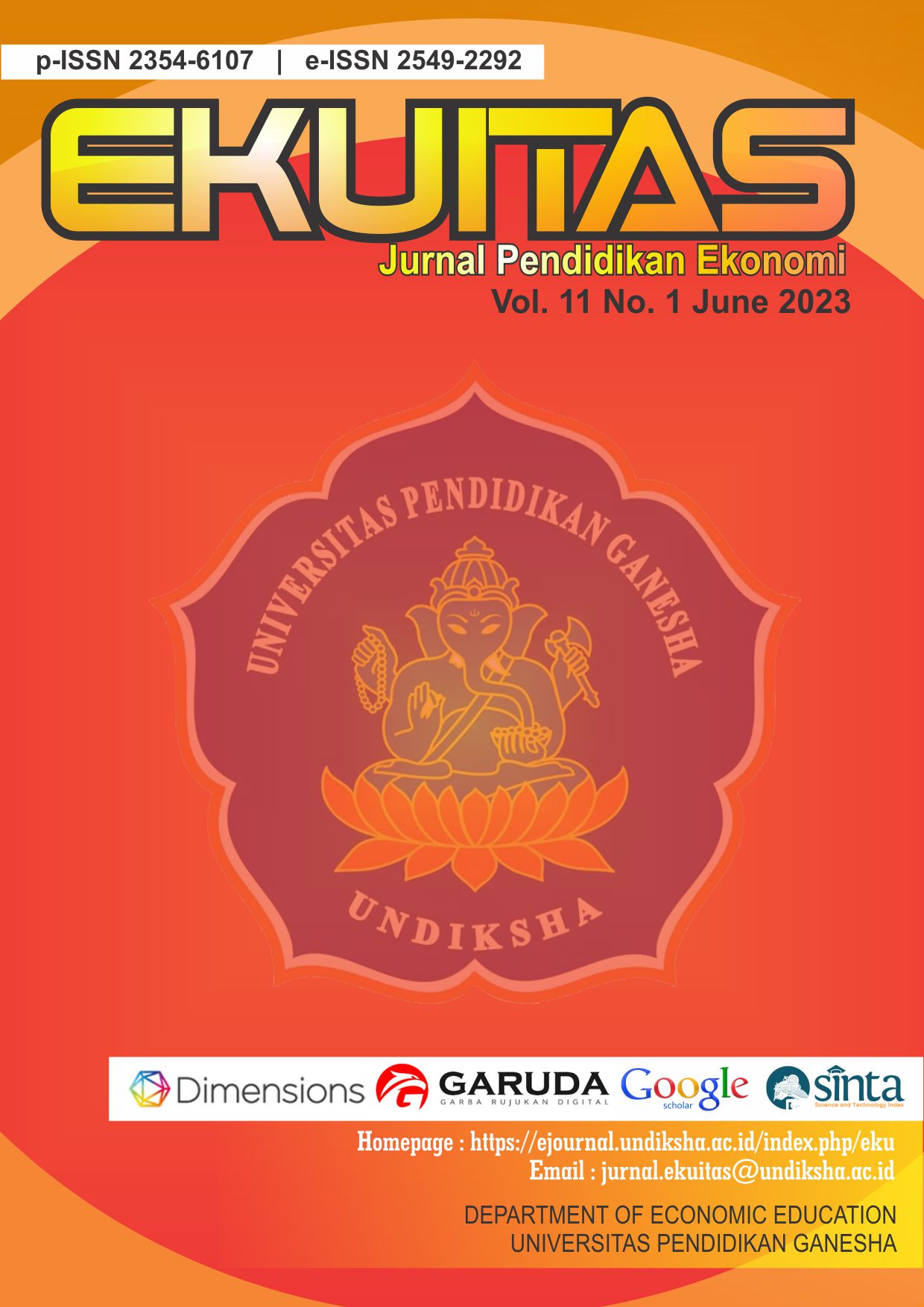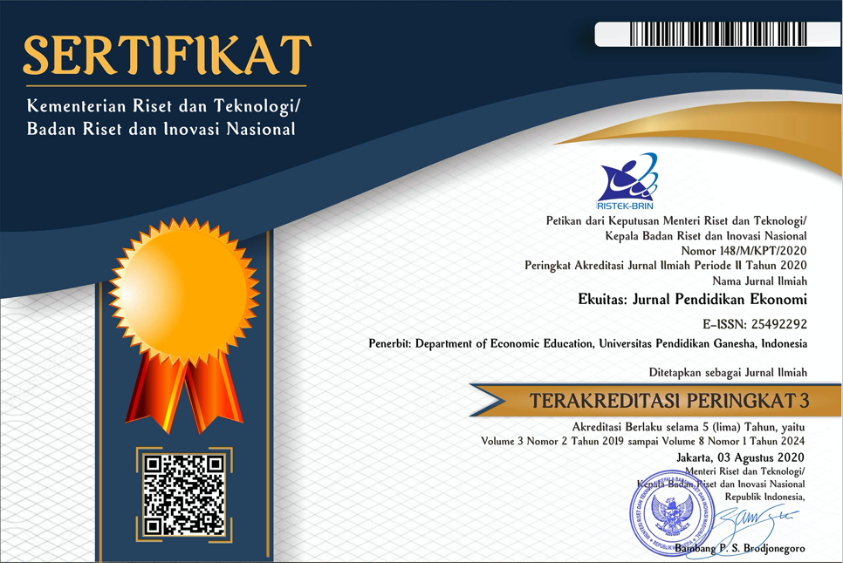Experience in Intention to Buy: Engagement as a Mediation in Retail Skincare Product
DOI:
https://doi.org/10.23887/ekuitas.v11i1.57741Keywords:
Brand engagement, brand experience, consumer-brand relationship, intention to buy, retail branding, PLS-SEM, skincare productsAbstract
The emergence of the number of skincare cosmetic retailers in Salatiga, Central Java, is one of the factors in which the percentage of women who are aware of the importance of skin health is increasing, especially since the causes of skin problems are currently various. It makes one of the retailers in Salatiga, namely G&G skin care cosmetics store, need to strengthen relationships with their customers to survive and achieve business excellence amid a competitive skincare market. This research was lifted from the curiosity of researchers regarding the significant influence of brand experience on the intention to buy products through G&G stores by using brand involvement as mediation. Data collection was carried out by distributing questionnaires to 100 respondents who had made purchases at G&G cosmetics retail at least once. The sample used in this research is judgmental sampling. The structural Equation Modeling (SEM) method with Partial Least Square (PLS) was applied in this study. Then, the result of this study shows that brand experience has a significant effect on the intention to buy a product, with the three indicators of brand involvement as mediation. Moreover, the results also show that G&G retail skincare brands need to increase their activation in brand engagement to attract and maintain relationships with their consumers in the long term.
References
Ainsworth, J., & Foster, J. (2017). Comfort in brick and mortar shopping experiences: Examining antecedents and consequences of comfortable retail experiences. Journal of Retailing and Consumer Services, 35(November 2016), 27–35. https://doi.org/10.1016/j.jretconser.2016.11.005
Ajzen, I. (1991). The Theory of Planned Behaviour. Organizational Behavior and Human Decision Processes, 50(2), 172–211. https://doi.org/10.47985/dcidj.475
Ariadi, G., Surachman, Sumiati, & Rohman, F. (2021). The effect of lean and agile supply chain strategy on financial performance with mediating of strategic supplier integration & strategic customer integration: Evidence from bottled drinking-water industry in Indonesia. Cogent Business & Management, 8(1), 1930500.
Ariadi, G. (2022). Inter-firm Collaboration and Knowledge Sharing as mediators of the interrelation between Asset Specificity and Innovative Performance. Bisma: Jurnal Manajemen, 8(2), 253-261.
Baek, E., Choo, H. J., Wei, X., & Yoon, S. Y. (2020). Understanding the virtual tours of retail stores: how can store brand experience promote visit intentions? International Journal of Retail and Distribution Management, 48(7), 649–666. https://doi.org/10.1108/IJRDM-09-2019-0294
Bairrada, C. M., Coelho, A., & Lizanets, V. (2019). The impact of brand personality on consumer behavior: the role of brand love. Journal of Fashion Marketing and Management, 23(1), 30–47. https://doi.org/10.1108/JFMM-07-2018-0091
Bigne, E., Andreu, L., Perez, C., & Ruiz, C. (2020). Brand love is all around: loyalty behaviour, active and passive social media users. Current Issues in Tourism, 23(13), 1613–1630. https://doi.org/10.1080/13683500.2019.1631760
Brakus, J. J., Schmitt, B. H., & Zarantonello, L. (2009). Brand Experience: What Is It? How Is It Measured? Does It Affect Loyalty? Journal of Marketing, 73(3), 52–68. https://doi.org/10.1509/jmkg.73.3.52
Camilleri, M. A., & Falzon, L. (2021). Understanding motivations to use online streaming services: integrating the technology acceptance model (TAM) and the uses and gratifications theory (UGT). Spanish Journal of
Marketing - ESIC, 25(2), 217–238. https://doi.org/10.1108/SJME-04-2020-0074
Dwivedi, A., Nayeem, T., & Murshed, F. (2018). Brand experience and consumers’ willingness-to-pay (WTP) a price premium: Mediating role of brand credibility and perceived uniqueness. Journal of Retailing and
Consumer Services, 44(June), 100–107. https://doi.org/10.1016/j.jretconser.2018.06.009
Farhat, K., Mokhtar, S. S. M., & Salleh, S. B. M. (2021). Role of brand experience and brand affect in creating brand engagement: a case of higher education institutions (HEIs). Journal of Marketing for Higher Education, 31(1), 107–135. https://doi.org/10.1080/08841241.2020.1759753
Fetscherin, M., Guzman, F., Veloutsou, C., & Cayolla, R. R. (2019). Latest research on brand relationships: introduction to the special issue. Journal of Product and Brand Management, 28(2), 133–139. https://doi.org/10.1108/JPBM-12-2018-2167
Fetscherin, M., Veloutsou, C., & Guzman, F. (2021). Guest editorial. Journal of Product and Brand Management, 30(3), 353–359. https://doi.org/10.1108/JPBM-04-2021-012
Greenwood-Gaynor Lea. (2013). Fashion Marketing Communications. John Wiley & Sons, Ltd.
Hair, J. F., Sarstedt, M., Hopkins, L., & Kuppelwieser, V. G. (2014). Partial least squares structural equation modeling (PLS-SEM): An emerging tool in business research. European Business Review, 26(2), 106–121. https://doi.org/10.1108/EBR-10-2013-0128
Han, H., Lee, K. S., Song, H. J., Lee, S., & Chua, B. L. (2019). Role of coffeehouse brand experiences (sensory/affective/intellectual/behavioral) in forming patrons’ repurchase intention: Impact of switching costs. Journal of Hospitality and Tourism Insights, 3(1), 17–35. https://doi.org/10.1108/JHTI-03-2019-0044
Hollebeek, L. D., Glynn, M. S., & Brodie, R. J. (2014). Consumer brand engagement in social media: Conceptualization, scale development and validation. Journal of Interactive Marketing, 28(2), 149–165. https://doi.org/10.1016/j.intmar.2013.12.002
Huang, C. C. (2017). The impacts of brand experiences on brand loyalty: mediators of brand love and trust. Management Decision, 55(5), 915–934. https://doi.org/10.1108/MD-10-2015-0465
Hwang, J., Choe, J. Y. (Jacey), Kim, H. M., & Kim, J. J. (2021). Human baristas and robot baristas: How does brand experience affect brand satisfaction, brand attitude, brand attachment, and brand loyalty? International Journal of Hospitality Management, 99(March), 103050. https://doi.org/10.1016/j.ijhm.2021.103050
Khan, A., Mohammad, A. S., & Muhammad, S. (2021). An integrated model of brand experience and brand love for halal brands: survey of halal fast food consumers in Malaysia. Journal of Islamic Marketing, 12(8), 1492–1520. https://doi.org/10.1108/JIMA-11-2019-0236
Lee, J. E., Goh, M. L., & Mohd Noor, M. N. Bin. (2019). Understanding purchase intention of university students towards skin care products. PSU Research Review, 3(3), 161–178. https://doi.org/10.1108/prr-11-2018-0031
Li, H., Wang, C. (Renee), Meng, F., & Zhang, Z. (2019). Making restaurant reviews useful and/or enjoyable? The impacts of temporal, explanatory, and sensory cues. International Journal of Hospitality Management, 83(May), 257–265. https://doi.org/10.1016/j.ijhm.2018.11.002
Naszariah, R., Naseri, N., Mohd Esa, M., Abas, N., Zamratul, N., Ahmad, A., Azis, R. A., & Norazmi Bin Nordin, M. (2021). An Overview Of Online Purchase Intention Of Halal Cosmetic Product: A Perspective From Malaysia. Turkish Journal of Computer and Mathematics Education, 12(10), 7674–7681.
Osei-Frimpong, K. (2019). Understanding consumer motivations in online social brand engagement participation: Implications for retailers. International Journal of Retail and Distribution Management, 47(5), 511–529. https://doi.org/10.1108/IJRDM-08-2018-0151
Safeer, A. A., He, Y., Lin, Y., Abrar, M., & Nawaz, Z. (2021). Impact of perceived brand authenticity on consumer behavior: an evidence from generation Y in Asian perspective. International Journal of Emerging Markets, 71772074. https://doi.org/10.1108/IJOEM-09-2020-1128
Sanny, L., Arina, A. N., Maulidya, R. T., & Pertiwi, R. P. (2020). Purchase intention on Indonesia male’s skin care by social media marketing effect towards brand image and brand trust. Management Science Letters, 10, 2139–2146. https://doi.org/10.5267/j.msl.2020.3.023
Schmitt, B. H., & Rogers, D. L. (2008). Handbook on brand and experience management. Handbook on Brand and Experience Management. https://doi.org/10.4337/9781848446151
Singh, D., Bajpai, N., & Kulshreshtha, K. (2020). Brand Experience-Brand Love Relationship for Indian Hypermarket Brands: The Moderating Role of Customer Personality Traits. Journal of Relationship Marketing, 20(1), 20–41. https://doi.org/10.1080/15332667.2020.1715179
Tsai, Y.-C., Chang, H.-C., & Ho, K.-C. (2015). A Study of the Relationship among Brand Experiences, Self-Concept Congruence, Customer Satisfaction, and Brand Preference. Contemporary Management Research, 11(2), 97–116. https://doi.org/10.7903/cmr.12970
Ueasangkomsate, P., & Santiteerakul, S. (2016). A Study of Consumers’ Attitudes and Intention to Buy Organic Foods for Sustainability. Procedia Environmental Sciences, 34, 423–430. https://doi.org/10.1016/j.proenv.2016.04.037
Uma, S., & Bougie, R. (2016). Research Method for Business 7th edition. Space Wileyplus Learning.
ZAP Beauty Clinic & Markplus Inc. (2021). ZAP Beauty Index 2021. Mark Plus Inc, 2013–2015.
Zha, D., Foroudi, P., Melewar, T. C., & Jin, Z. (2022). Experiencing the sense of the brand: the mining, processing and application of brand data through sensory brand experiences. Qualitative Market Research. https://doi.org/10.1108/QMR-09-2021-0118
Zhao, Y., Ni, Q., & Zhou, R. (2018). What factors influence the mobile health service adoption? A meta-analysis and the moderating role of age. International Journal of Information Management, 43(December 2016), 342–350. https://doi.org/10.1016/j.ijinfomgt.2017.08.006
Downloads
Published
How to Cite
Issue
Section
License

This work is licensed under a Creative Commons Attribution-ShareAlike 4.0 International License.








